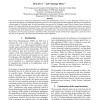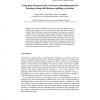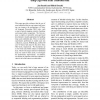82 search results - page 2 / 17 » Using Three Way Data for Word Sense Discrimination |
LREC
2010
13 years 7 months ago
2010
Given the recent trend to evaluate the performance of word sense disambiguation systems in a more application-oriented set-up, we report on the construction of a multilingual benc...
AIME
2001
Springer
13 years 10 months ago
2001
Springer
Abstract. We report on the design of a system for correcting spelling errors resulting in non-existent words. The system aims at improving edition of medical reports. Unlike tradit...
AAAI
2006
13 years 6 months ago
2006
The scarcity of manually labeled data for supervised machine learning methods presents a significant limitation on their ability to acquire knowledge. The use of kernels in Suppor...
ACL
2008
13 years 7 months ago
2008
This paper provides evidence that the use of more unlabeled data in semi-supervised learning can improve the performance of Natural Language Processing (NLP) tasks, such as part-o...
PR
2010
13 years 3 months ago
2010
: Dimensionality reduction methods (DRs) have commonly been used as a principled way to understand the high-dimensional data such as face images. In this paper, we propose a new un...



